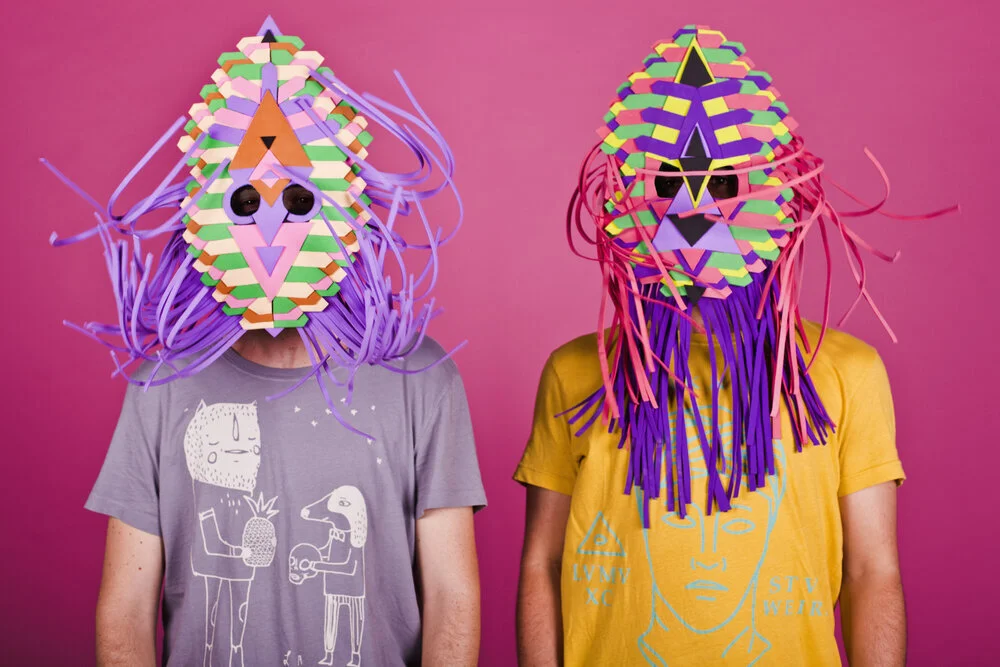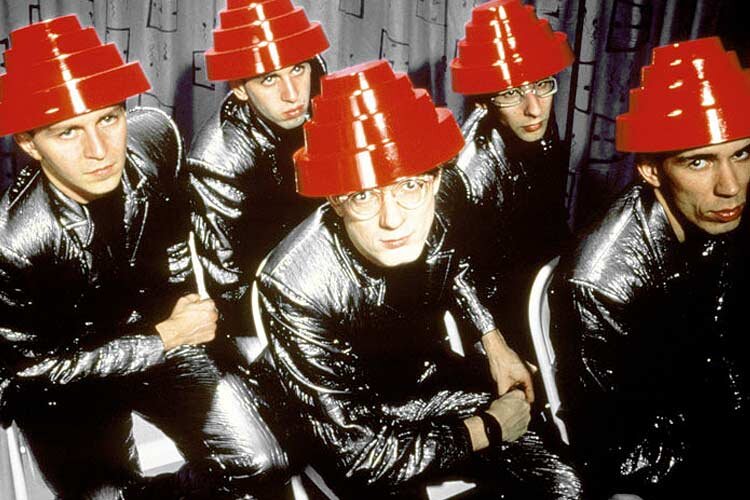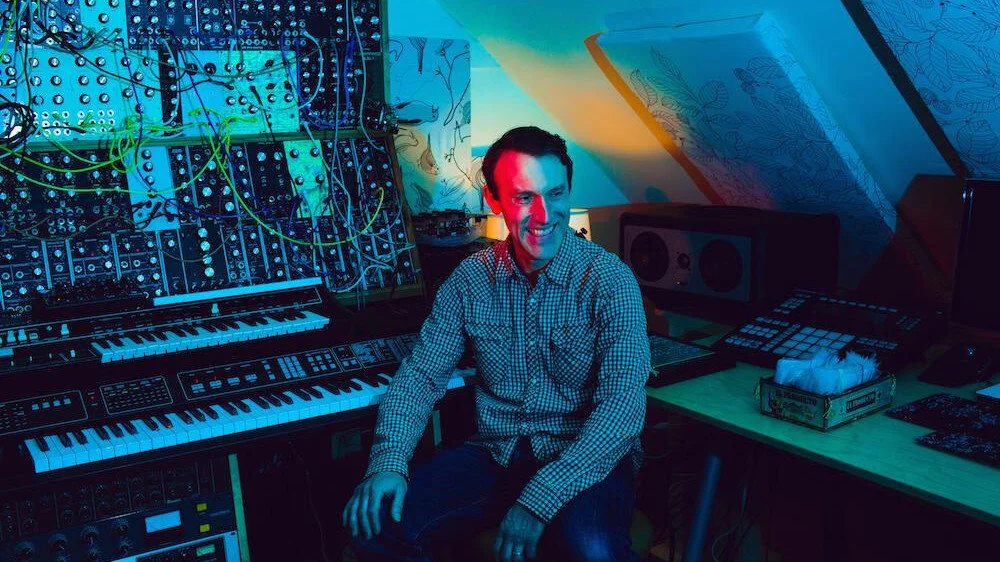The Alternate Universe of Dengue Dengue Dengue
Behind the Technicolor masks worn by Peruvian tropical bass duo Dengue Dengue Dengue are Felipe Salmon and Rafael Periera. The tropical sonic warriors bridge continental divides by uniting the Danelectro-fueled surf rock of sun-bleached 1970s California with psychedelic rock, Caribbean dancehall, German techno, and Amazonian cumbia on the new “Siete Raíces.” It’s a fusion borne of conquistadors, imperialists, and spice traders melding African and Asian rhythms with the tribal Afro-Peruvian sounds of the Andes.
In a video interview for Noisey, we are invited into a conversation about “Making Music in the Third World.” We are also beckoned into the universe of the “Simiolo”video, where two scantily-clad, hip-gyrating beauties part a pink bedazzled curtain. A spaceship flight to an alternate universe launches while a Star Wars-like glowing neon graphic gives way to Salmon and Periera. The duo emerges with matching tracksuits and their backs to the camera. A spaceship appears as the track kicks. Is Barbarella going to join us? Is there interstellar life in nearby galaxies? Nothing is certain, but we’re lucky to be abducted.
Dengue Dengue Dengue effortlessly merge disparate influences into something so wholly original that they create a new genre, a new continent, and a new galaxy. We caught up with Salmon and Periera to discuss the “Simiolo” video, production techniques and favorite albums, from 1960s psychedelic cumbia to recent releases.
How did the “Simiolo” video come together?
We shot the video in early 2012 after we wrote its storyline with director Mika Stornfelt. The original story had all these different elements, but because we had a limited budget, we couldn’t really produce all we needed to make the story work. We then decided to shoot all these elements separately and make a collage of images that represent our own view of Peruvian chicha culture, mixed with some influences of Mexico’s tribal Guarachero and other Latin American influences.
Can you describe the Auxiliar collective, and how you came together?
Auxiliar was an audiovisual collective we started with three other friends. It came together out of our need for a new underground electronic scene in the city of Lima. We worked together from 2007 to 2015, creating parties, audiovisual installations and a record label where we released our first LP.
How are your tropical bass parties in Lima different from events you’ve played in Berlin, London, New York or Tokyo?
When we play in Peru or other Latin American countries, the audience is already familiar with cumbia and other local rhythms. Cumbia has been around them all their lives, so it’s easy for them to follow it and dance. But if we play some kuduro or footwork genres it’s difficult for them to follow this, so we usually bring some elements of these rhythms to our sets, and mix them with local sounds so the audience gets some familiar elements. When we play in Europe, the audience there is multicultural and already familiar with African rhythms or new electronic genres like zouk bass, so we usually make our sets more global, sound-wise.
How has your artistic or creative process changed from 2012’s La Alianza Profana?
La Alianza Profana was made almost entirely on FL Studio, with some tracks made in Ableton Live. This second LP is made entirely on Live and has some collaborations with other artists. We invited Sara Van for the vocals of “Guarida,” the second single of the album, and there’s also a track with Branko and Toy Selectah. Production-wise, it hasn’t changed that much from the other releases, but we did use some new software: Reaktor by Native Instruments.
We also believe this is a year for collaborations, so we are looking to fuse our sound with that of other artists and want to make a full collaborative LP.
How do you merge different genres? Are you conscious of doing this, or is it a by-product?
This is actually what this project is about: exploring and mixing different rhythms and sounds to get a new hybrid. It’s really interesting to find new ways to mix elements of one culture with another. The result is usually refreshing and opens a wide range of creative flow on the production of sounds and images.
Can you talk a little bit about the cumbia chicha poster tradition, and how you’ve reinterpreted that?
The chicha poster tradition dates back to the popularity of chicha music during the ‘80s and ‘90s. We used this influence in our first masks and applied the colors in our own way, mixing it with the masquerade carnival traditions of the Peruvian highlands.
There’s a German word, “Gesamtkunstwerk,” meaning “total work of art,” referring to art installations that affect all five human senses. You’re a good example of this, as your music informs your art. Do you agree?
Yes, we see Dengue Dengue Dengue as an audiovisual project. We decided to work on developing graphics, visuals, the masks and everything around the music from inception. We always say that if we could make people smell and taste our shows we would do it.
What does your live setup look like?
We are always changing the setup of our live set depending on the new gear we can get. Now we are using Ableton Live, two MK2 Maschines, a Rane 64 mixer, Traktor F1 for visuals and two MacBooks.
What are your top cumbia tracks from the 1960s or 1970s?
We have many tracks we love, so maybe it’s better to mention some of the groups we like. All of them have many tracks that are amazing: Los Wemblers de Iquitos, Rail, Los Titanes, Los Ribereños, Los Orientales de Paramonga, Los Destellos and Los Mirlos.
Any favorite cumbia labels?
The most important one in cumbia has to be Infopesa. They re-launched the label three years ago and are releasing old and new stuff from their catalog. There’s also Odeon and Sonoradio.
Did you grow up in Lima? How has the city changed in the past few years?
Yes, we grew up in Lima. It has changed a lot in the recent past mainly because of globalization and the Internet, which brings both good and bad influences. Radio stations and the general public usually listens to ‘80s and ‘90s music, but this is slowly changing in the recent years. Now it’s easier to share what we do in Peru with the rest of the world, and this has made the music scene stronger, especially in the capital.
Can you list your top five vinyl records (each)?
Rafael:
Boards of Canada, Music Has the Right to Children
My Bloody Valentine, Loveless
Aphex Twin, Selected Ambient Works 85-92
Mount Kimbie, Crooks and Lovers
Los Samplers, Descargas
Felipe:
U-ziq, Lunatic Harness
Ranil y Su Conjunto Tropical, Ranil’s Jungle Party
Daft Punk, Homework
Señor Coconut, El Baile Alemán
Squarepusher, Go Plastic
This article originally written for Napster.




